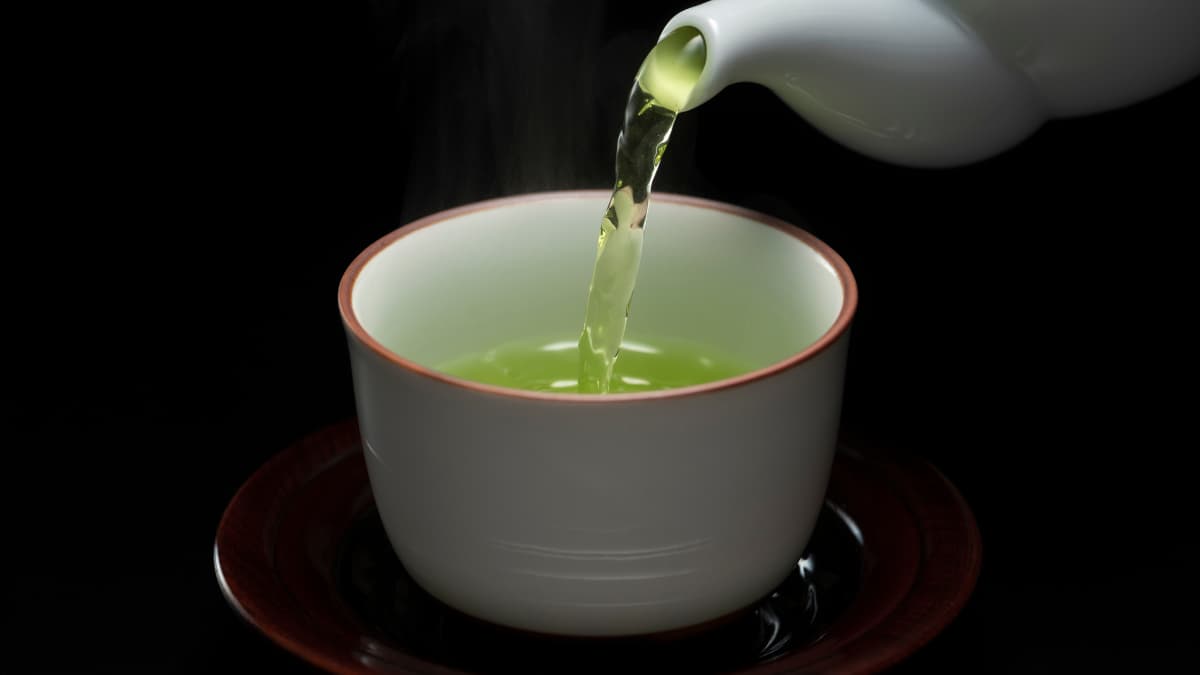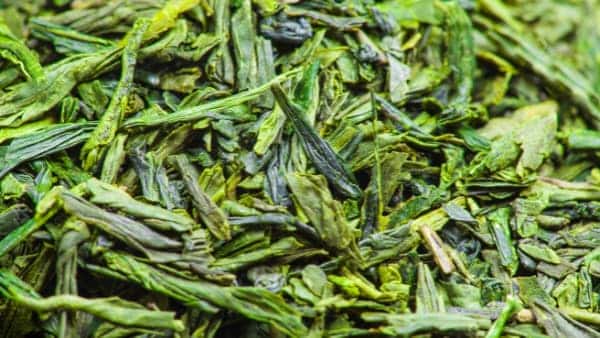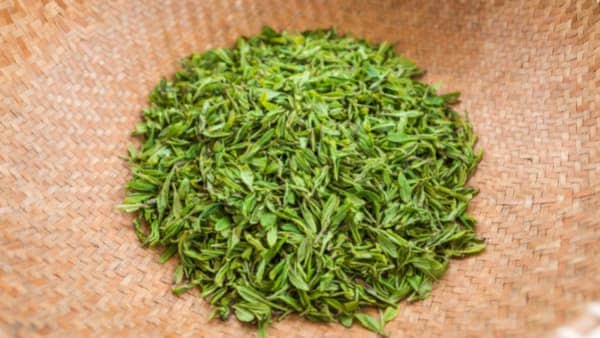How Much Caffeine Is in Green Tea?
You’ve no doubt heard all about the potential health benefits of a cup of green tea. But how much caffeine is in green tea?
There is a prevailing myth that green tea doesn’t have caffeine. But if you’re concerned about caffeine consumption, you need to know the truth.
In this article, I’ll discuss how consuming green tea can affect your daily caffeine intake. And I’ll go over some surprising ways you can reduce the total caffeine content in green tea.

Does Green Tea Have Caffeine?
Yes, green tea does have caffeine. The beverage is made using the leaves of the Camellia sinensis tea plant. And these leaves naturally contain caffeine.
Caffeine is a central nervous system stimulant. Some people find it makes them feel more alert and able to focus on complex tasks.
Other people have negative reactions to caffeine. The stimulant can make some people feel anxious and jittery.
As with any plant-based beverage, the amount of caffeine in green tea will vary depending on several factors. Tea origin, processing, and brew method will impact the total amount of caffeine in the beverage.
Of course, green tea contains more than just caffeine. It’s packed with healthy antioxidants that may provide many health benefits.
According to researchers, the plant may protect against the effects of aging and promote weight loss. It might even improve brain function.
For some people, the health benefits of green tea may outweigh any negative effects of caffeine.
Green tea contains the amino acid L-Theanine. Some studies suggest this amino acid lowers anxiety, improves mood, and increases brain function. Improved mood from a tasty drink sounds like a good fix!
What makes green tea different from black tea? Green tea comes from the same tea plants as black tea but is less processed. That’s why the color is a fresh green hue and the taste is more subtle than the black version.
But what about the caffeine in green tea compared to black tea? In general, black tea has a greater caffeine amount. But let’s look at green tea caffeine in more detail.
How Much Caffeine in Green Tea?
If you need to limit your caffeine consumption, you may be wondering about the levels of caffeine in green tea.
Here’s the quick answer: an 8 oz cup of green tea contains anywhere between 30 and 50 mg of caffeine.
The longer answer? Green tea caffeine can vary greatly depending on all those factors I mentioned earlier in the article, plus some others I’ll mention in a bit. Those factors can extend the caffeine that green tea contains from a minimal 10 mg to levels about as high as a drip coffee. That’s quite a range!
For instance, Japanese bancha tea, which is a late-harvest tea, has as little as 10 mg of caffeine. A Starbucks iced green tea has 25 mg. Sencha tea, which uses younger tea leaves, has a higher caffeine content, coming in at about 30 mg. And twig tea has a similar caffeine content to Sencha tea.
That means that some green tea blends, using the same amount in weight, have more caffeine than others. When we talk about powdered green tea, though, we go completely beyond that scale.
Why? With powdered tea, you consume the whole leaf rather than just an infusion made with the leaf and hot water. So powdered green tea has a higher caffeine content. Ingesting all the caffeine in green tea leaves can give you about 180 mg of caffeine per cup!
Any of these teas can increase your energy levels. Of course, green tea isn’t the only beverage that has caffeine. But will you find the same levels of caffeine in green tea in other caffeinated drinks?

Green Tea Caffeine vs Other Drinks
How does the caffeine in green tea stack up against other caffeinated beverages? Some common beverages valued as stimulants are brewed coffee, soda, black tea, white tea, Oolong, and hot chocolate.
Let’s take a look at them side by side. Here’s the amount of caffeine you’ll get per 8-ounce serving:
- Brewed coffee – as much as 100 mg of caffeine
- Cola soft drinks – 22 mg
- Black tea – around 47 mg
- Oolong – 40 to 50 mg
- White tea – 15 – 30 mg
- Hot chocolate – from 5 to as much as 25 mg, depending on the type of cacao
- Energy drinks (e.g Red Bull) – around 72 mg
It’s well known that coffee and energy drinks have caffeine. But the caffeine content in other drinks might surprise you.
For example, hot chocolate can be quite a stimulant, with up to 25 mg per cup.
Other caffeinated beverages such as cola soft drinks can have about 22 mg of caffeine. Many citrus-based sodas or root beers don’t have any caffeine at all.
Unlike energy drinks and soft drinks, green tea has those health benefits we already discussed.
Green tea has less caffeine than other caffeinated beverages. But is that small amount of caffeine a health hazard?
Is the Caffeine in Green Tea a Problem?
Now that you know that green tea contains caffeine, do you need to change something in your diet?
If consuming caffeine poses a problem for your health, you may need to consider how green tea affects your health. Tea plants generally provide many health benefits. But you also want to make sure you manage any potential negative effects.
Since the negative side of green tea is the amount of caffeine it contains, let’s talk about what a healthy limit of the stimulant would be.
The generally held belief is that up to 400 mg of caffeine daily is fine for most people. How does that translate into the number of cups you can drink?
Assuming your cup of green tea has the normal 30-50 grams, even 8 cups of tea a day may not affect you.
Green tea has as little as 10 mg of caffeine per serving. That means you could potentially consume as much as 40 cups of this beverage and still not get close to the upper limit. That’s a lot of tea in one day!
So drinking green tea shouldn’t be a problem for most people. Of course, if you’re particularly sensitive to caffeine, you may need to stay well below those limits. You may even feel the need to cut caffeine out of your diet completely. Could decaf green tea help you with that goal?
While many people feel that decaf tea is a way to go caffeine free, that’s not the case. Decaf green tea does have lower amounts of caffeine than regular green tea. But remember the difference – decaf tea is not caffeine free; it just has less caffeine.
Like decaf coffee beans, decaffeinated green tea will always contain some amount of caffeine. The exact amounts depend on the brand.

What if you want to reduce the caffeine in your diet but can’t give up green tea? Good news. There are several things you can do to reduce the amount of caffeine in green tea.
The amount of caffeine in green tea can vary depending on many factors. Let’s look at some steps you can take to reduce the caffeine content of green tea:
Choose late-harvest leaves. Some blends of green tea come from leaves at the start of the harvest season. Other blends use older leaves. The caffeine content decreases as the leaves get older. So younger tea leaves contain more caffeine. To avoid the stimulant, look for blends made from older leaves, such as bancha.
Release the leaf. Loose-leaf teas often reduce caffeine content. Why would that make a difference? When manufacturers make tea bags, they crush the leaves to fit them into the bag. Crushed leaves release more caffeine into the water during brewing. If you want to lower your caffeine consumption, you might want to avoid green tea bags and go for loose-leaf. Release the leaf and reduce the amount of caffeine in the final drink.
Avoid powdered green teas. Powdered tea comes from pulverized leaves. In this type of drink, the whole leaf suspends in the water. When you consume the actual leaf and not just an infusion made from the leaves, you get an extra caffeine kick.
Keep an eye on the clock. A brewing method that includes a shorter steep time may extract less caffeine. Some types of green tea are ideal after a brewing time of just 30 seconds. Others taste good at one and a half minutes, and others take four minutes.
Adjust the ratio. The general recommendation for tea is to use one teaspoon of leaves per 8 ounces of water. But you might be wondering how much tea that really is. After all, one teaspoon can vary in size from another. If you want to get precise, try weighing your leaves rather than measuring them. A rule of thumb is 3 mg per serving. But feel free to use less tea and find the perfect ratio for your preferences.
Control the heat. Boiling water releases more caffeine than water at a lower temperature. Use water just off the boil to brew your beverage.
Wrapping Up
Green tea does offer many health benefits, primarily thanks to the amino acid L-Theanine.
Studies suggest that green tea might contribute to a reduced risk for disease and promote weight loss. It might also improve brain function and increase energy levels.
In some cases, a moderate amount of caffeine might even lead to an improved mood.
If consuming caffeine is an issue for you, keep in mind that green tea does contain caffeine. Green tea won’t caffeinate you as much as coffee. But you still might want to be careful.
Know the average amount of caffeine in your beverage. That way you can plan how much you should drink each day to meet your health needs.
And keep in mind that you do have some control over the amount of caffeine in your cup of tea.
Want to cut your caffeine intake? Choose decaffeinated leaves. Adjust the ratio of leaves to water. Reduce the steep time. And use whole loose-leaf tea. (Crushed or powdered tea leaves increase caffeine extraction.)
No matter what you decide to consume, keep your leaves fresh. Remember to consume green tea within six months of purchasing it.
Store it in an airtight container where it’s safe from humidity and oxygen. And enjoy the fresh, natural taste of this beloved beverage.

